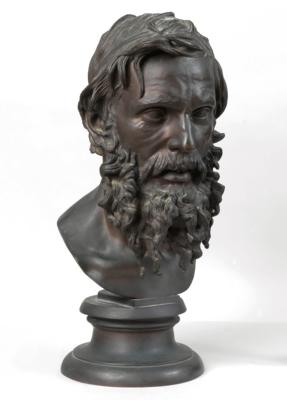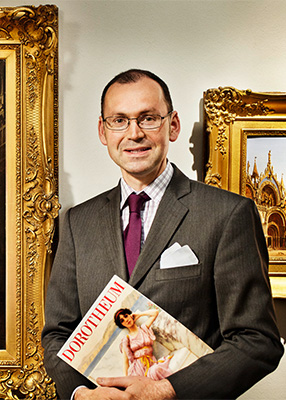Vincenzo Gemito

(Naples 1852–1929)
The Philosopher, c. 1886, second version, founder’s marks, signed Gemito, bronze, height 48.5 cm
Provenance:
Chines Collection, Italy.
Catalogued and illustrated in:
Exhibition catalogue, Rome, GOMP, Cinzia Virno and Manuel Carrera, Gemito, Mancini e il loro ambiente. Opere giovanili, 2007;
Exhibition catalogue, Paris, Petit Palais - Musée des Beaux-Arts de la ville, Gemito - le sculpteur de l‘âme napolitaine, 2019, no. 21;
Exhibition catalogue, Naples, Museo di Capodimonte, Gemito - Dalla scultura al disegno, 2020, p. 188, no. 20.
We are grateful to Dr. Maria Simonetta De Marinis for the scientific assistance.
Vincenzo Gemito’s Head of a Philosopher was cast around 1886, when he was working in his own foundry financed by De Mesnil. The philosopher’s head from the Achille Minozzi collection, now owned by the Capodimonte Museum in Naples, dates from c. 1883-1886. It was presented at the Petit Palais in Paris and then at the Capodimonte Museum for an exhibition on Gemito held in 2019. On the same occasion, the present lot from the Chines Collection in Rome,
c. 1886, was also published in the relevant catalogue.
One of the main inspirations for Gemito’s Philosopher’s Head was the portrait of the pseudo-Seneca in the Archaeological Museum of Naples. However, the artist’s most important reference in depicting his subject was his adoptive father, Francesco Jadicicco, nicknamed ‘Masto Ciccio’, whom he portrayed several times in sketches and drawings.
In the present lot, the incisive chiseling outlines the details of the face, the hair and the beard. It delineates the wrinkles around the character’s eyes with greater insistence and highlights his teeth. The details imitate reality and are undoubtedly closer to the faithful representation of the face of ‘Masto Ciccio’, his adoptive father and the main source of inspiration for this work.
Nevertheless, even in this version the reference to antiquity is present. By placing four small foundry punches on this sculpture, plus the circular stamp and, of course, the signature, Gemito probably wished to allude to the beauty of the execution and the importance of this work, thus expressing his satisfaction with the result.
Maria Simonetta De Marinis
Esperto: Gautier Gendebien
 Gautier Gendebien
Gautier Gendebien
+39-334-777 1603
Gautier.Gendebien@dorotheum.it
10.05.2022 - 16:00
- Stima:
-
EUR 15.000,- a EUR 20.000,-
Vincenzo Gemito
(Naples 1852–1929)
The Philosopher, c. 1886, second version, founder’s marks, signed Gemito, bronze, height 48.5 cm
Provenance:
Chines Collection, Italy.
Catalogued and illustrated in:
Exhibition catalogue, Rome, GOMP, Cinzia Virno and Manuel Carrera, Gemito, Mancini e il loro ambiente. Opere giovanili, 2007;
Exhibition catalogue, Paris, Petit Palais - Musée des Beaux-Arts de la ville, Gemito - le sculpteur de l‘âme napolitaine, 2019, no. 21;
Exhibition catalogue, Naples, Museo di Capodimonte, Gemito - Dalla scultura al disegno, 2020, p. 188, no. 20.
We are grateful to Dr. Maria Simonetta De Marinis for the scientific assistance.
Vincenzo Gemito’s Head of a Philosopher was cast around 1886, when he was working in his own foundry financed by De Mesnil. The philosopher’s head from the Achille Minozzi collection, now owned by the Capodimonte Museum in Naples, dates from c. 1883-1886. It was presented at the Petit Palais in Paris and then at the Capodimonte Museum for an exhibition on Gemito held in 2019. On the same occasion, the present lot from the Chines Collection in Rome,
c. 1886, was also published in the relevant catalogue.
One of the main inspirations for Gemito’s Philosopher’s Head was the portrait of the pseudo-Seneca in the Archaeological Museum of Naples. However, the artist’s most important reference in depicting his subject was his adoptive father, Francesco Jadicicco, nicknamed ‘Masto Ciccio’, whom he portrayed several times in sketches and drawings.
In the present lot, the incisive chiseling outlines the details of the face, the hair and the beard. It delineates the wrinkles around the character’s eyes with greater insistence and highlights his teeth. The details imitate reality and are undoubtedly closer to the faithful representation of the face of ‘Masto Ciccio’, his adoptive father and the main source of inspiration for this work.
Nevertheless, even in this version the reference to antiquity is present. By placing four small foundry punches on this sculpture, plus the circular stamp and, of course, the signature, Gemito probably wished to allude to the beauty of the execution and the importance of this work, thus expressing his satisfaction with the result.
Maria Simonetta De Marinis
Esperto: Gautier Gendebien
 Gautier Gendebien
Gautier Gendebien
+39-334-777 1603
Gautier.Gendebien@dorotheum.it
|
Hotline dell'acquirente
lun-ven: 10.00 - 17.00
kundendienst@dorotheum.at +43 1 515 60 200 |
| Asta: | Dipinti dell’Ottocento |
| Tipo d'asta: | Asta in sala con Live Bidding |
| Data: | 10.05.2022 - 16:00 |
| Luogo dell'asta: | Wien | Palais Dorotheum |
| Esposizione: | 30.04. - 10.05.2022 |
